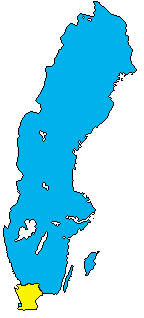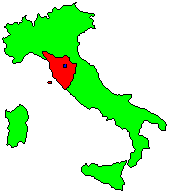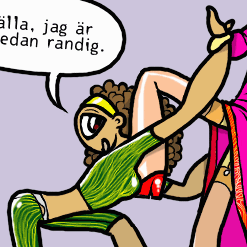The Florentine Pogen Cookies
 THE COOKIES IN THE PICTURE were once
available in America under the name "FLORENTINE POGENS". They were still available in Sweden as of March 1999, their
Swedish name is "TOSCA-PÅGAR", and they are from a Scanian bakery called
PÅGEN. If you've ever wondered what a "florentine pogen" is - you're
looking at them.
THE COOKIES IN THE PICTURE were once
available in America under the name "FLORENTINE POGENS". They were still available in Sweden as of March 1999, their
Swedish name is "TOSCA-PÅGAR", and they are from a Scanian bakery called
PÅGEN. If you've ever wondered what a "florentine pogen" is - you're
looking at them.
[This page is dedicated to Jon Naurin, who really got the ball rolling.]
 |
Since the year 1974, when Frank Zappa started playing the song "Florentine Pogen" in concert, people have been wondering what on God's grey earth a Florentine Pogen is. The song starts with the lines
She was the daughter of a wealthy Florentine Pogen;
"Read 'em & weep" was her adjustable slogan [1]
and in a popular theory of least resistance (among people who know no Italian), a Pogen is an Italian nobleman. Not so. The Florentine Pogen cookies were first brought up by Björn Lisper, Sweden:
"Pogens" is an anglified spelling of the Swedish bakery "Pågens" ... "Pågens" is southern Swedish dialect and means "the boy's" (cookies, say). In Sweden, Pågens makes all sorts of cookies, bread etc. It turns out that these Florentine Pogens being sold in California are a type of cookie that Pågens sells in Sweden, but under a different name. So Pågens seems to have some business in California as well.
Don White in Texas confirmed it:
It's a cookie. My mom went to the store one time (this was in 1979), and came back [with] bags of groceries. She had not known what she had done when she bought the package of Pogens, but I roared in amazement and delight at the sight. She thought I was nuts. The company that made Pogens made other kinds as well, 'though I couldn't tell you now what they were. Chocolate Pogens? Mallomar Pogens? Pecan Pogens?
Jon Naurin, in Gothenburg, Sweden, did some research:
Here's some more precise info:
Florentine Pogens: 88c/6 oz. (box)
The toffee wafer dipped in real chocolate has an aura of excitement. A rich, melt-in-your-mouth experience that may be too sophisticated for some tastes. Good for entertaining and great company while watching television. Sticky and chewy, a delight to the senses. Good frozen too.
(Stop drooling, Ninja!) Florentine Pogens can't be bought in the US anymore, as the Pogens Family Bakery shut down their factory in Compton in 1992. [Extra, extra: read all about it!] In Sweden, we can still buy it under the name Toscapågar.

That's right, you can still get the actual, original, HISTORICAL Florentine Pogen cookies as in all likelyhood eaten by Frank Zappa in Sweden! The cookies in the picture were bought in an ordinary Swedish supermarket [2] on March 4, 1999. They are the actual Florentine Pogen cookies - the name is different in Swedish, the packaging is of course different from 1970s-style American packaging, but the cookies inside are the same. They are between 5 and 6 centimeters across, and only a few millimeters thin.
(Daughter of a Wealthy Cookie?
While a Florentine Pogen undeniably is a cookie, Zappa certainly wasn't using the term literally, as in daughter of a wealthy cookie. What he did mean exactly, if he meant anything more than nonsense, is not known (and will probably never be). Perhaps it is a derogatory description.)
How "Pågen" became "Pogen", and "Pågar" became "Pogens"
 The Pågen bakery offers a wide range of cookies; they
all come in uniform packaging (each variety has its own colours) and they are all called
"pågar". As Björn Lisper has pointed out, "Pågen"
is Scanian (a southern Swedish dialect) for "The Boy".
(The company logo features a little baker boy.) Pågar, in Scanian, means
"boys". [3]
The Pågen bakery offers a wide range of cookies; they
all come in uniform packaging (each variety has its own colours) and they are all called
"pågar". As Björn Lisper has pointed out, "Pågen"
is Scanian (a southern Swedish dialect) for "The Boy".
(The company logo features a little baker boy.) Pågar, in Scanian, means
"boys". [3]

Often, when Swedish companies go international, they anglify their names by removing little dots and rings above certain vowels that English doesn't recognise; for example, Skånska cementgjuteriet ("The Scanian Cement Foundry" - a construction company) changed and shortened its name to Skanska, losing all Swedish meaning. In Swedish, the vowel Å (an A with a ring) is not seen as a subordinate variant of A, but as a completely different vowel, as different as E from O, and removing the ring can render a different word or a nonsense word with a totally different pronunciation - it just looks similar to foreigners. Pågen went the other way - they changed it to Pogen instead, because it sounds the same. In standard Swedish, "Pågen" is pronounced much like English "pawgen", if there was such a word, but the Scanian pronunciation is widely different and sounds just like English "pogen". Even though "pogen" doesn't mean anything in English, it looks completely acceptable and is a very nice word. The plural form was the obvious choice when it came to naming the cookie line. [4]
From "Tosca" to "Florentine"
 "Pågar"
became "Pogens", and "Tosca" became "Florentine".
Why "Tosca" in the first place? We're not sure; but cookies and more importantly
cakes with a special type of icing, containing slices of sweet almond [5],
are called Tosca cakes or Tosca cookies in Swedish:
"Toscakakor". (The Florentine Pogens don't have any sweet almond in them (see Ingridients), but they do have hazelnuts, which is close enough.)
And the city of Florence is the regionial capitol of Tuscany, which is called "Toscana"
in Italian - hence, "Florentine Pogens".
"Pågar"
became "Pogens", and "Tosca" became "Florentine".
Why "Tosca" in the first place? We're not sure; but cookies and more importantly
cakes with a special type of icing, containing slices of sweet almond [5],
are called Tosca cakes or Tosca cookies in Swedish:
"Toscakakor". (The Florentine Pogens don't have any sweet almond in them (see Ingridients), but they do have hazelnuts, which is close enough.)
And the city of Florence is the regionial capitol of Tuscany, which is called "Toscana"
in Italian - hence, "Florentine Pogens".
- Pogens Pointed Toward New Products - an article about the sale of Pogens in 1992, by Bernard Pacyniak, provided by the Duke.
Readers' Comments
From Fast Frank:
... and what yummy little cookies they are! Believe it or don't, they actually showed up in a vending machine at work one time ... I used to buy every freakin' bag they had.
Notes
[1] On the albums One Size Fits All, You Can't Do That on Stage Anymore Volume 4 and The Best Band You Never Heard in Your Life.
[2] The B&W supermarket in Brunna, a sub-suburb of Kungsängen, just north-west of Stockholm. The cashier girl looked just like this:
[3] Non-Swedish speakers may find it bizarre that we go around calling these common cookies "boys", but the Scanian word form has all but disappeared nowadays (standard Swedish has "pojkar" for "boys"), and has very little meaning for most Swedish people, who live north of Scania.
[4] A final note on the Scanian: "påg" means "boy", "pågen" means "the boy", and "pågar" means "boys". "The boy's" would be "pågens" - no apostrophe (').
[5] This definition of tosca icing is from the Bra Böckers dictionary.
Appendix
Now, we've covered everything potentially relevant to understanding these cookies, and move on to something as completely idiotic as a complete transcription and translation of all the print on the plastic wrapping around the cookie box, with extensive commentary. Feel free to stop reading at any time.
Top
On the top side, we find "TOSCA PÅGAR" ("Florentine Pogens"). [6] Below, in blue, we read
Tunna, knäckiga Toscaflarn
doppade i choklad
A literal translation is difficult, because a) the word "knäckiga" is not in general use in Swedish and was probably made up by the Pågen copywriters, and b) "flarn" has no direct equivalent in English. "Knäckiga" is an adjective derived from the verb "knäcka", to crack [something] ("knäck" is also a traditional Christmas candy, not at all "knäckig" and certainly not intended here), and "flarn" is a word that can be loosely used to denote thin cookies of many varieties. Substituting "cracky" and "cookies", the phrase could be rendered as
Thin, cracky Tosca cookies
dipped in choccolate
Below we read, in red,
DE KLASSISKA SMÅKAKORNA
which means simply "THE CLASSIC COOKIES". (The Swedish "kaka" means both "cake" and "cookie" - if you want to specify that it's a cookie, you prefix "små-", meaning "small".)
Also, printed in black on the clear part of the plastic is
Vikt. 145 g
Bäst Före:
08 08 99
 This is plainly the weight ("Vikt") of the contents: 145 grammes, and a
best-before ("Bäst Före") date - August 8 1999. [7]
(According to Jon Naurin's sources, the net weight of an American Florentine Pogen box was
6 ounces - approximately 170 grammes.) Also on this side is Pågen's logo -
the letters "pågen" underneath a baker boy in traditional Scanian clothing,
printed in white and red.
This is plainly the weight ("Vikt") of the contents: 145 grammes, and a
best-before ("Bäst Före") date - August 8 1999. [7]
(According to Jon Naurin's sources, the net weight of an American Florentine Pogen box was
6 ounces - approximately 170 grammes.) Also on this side is Pågen's logo -
the letters "pågen" underneath a baker boy in traditional Scanian clothing,
printed in white and red.
Sides
One of the sides of the package has the emblem of the Swedish Royal Family, with the legend "KUNGLIG HOVLEVERANTÖR" - "PURVEYOR TO THE ROYAL COURT". An official endorsement! [7.5] To the right of this, we read:
Pågen är ett familjebageri med traditioner sedan 1878.
Nu som då är kvaliteten och omsorgen om våra
kakor det viktigaste för oss. Av de bästa råvaror
bakar våra duktiga konditorer utsökta Pågar
- kvalitetsbenämningen på våra läckraste kakor.
(Pågen is a family bakery with traditions dating back to 1878.
Now, as then, the quality [of] and care for [!] our
cookies is our top priority. From the best ingredients,
our skilled pastry cooks make exquisite Pogens
- the quality name for our most delicious cookies.)
From this it would appear that Pågen makes not only the Pågar cookies, but others as well (if less delicious). Most people know nothing about these other cookies, if they even exist. Pågen is known to produce bread, though. The opposite side packs away another, smaller, Pågen logo and the familiar "TOSCA PÅGAR / Tunna, knäckiga Toscaflarn doppade i choklad".
Bottom
The bottom has a bar code (7 311070 340181) and two more texts, called "Ingredienser" and "SMAKGARANTI". "SMAKGARANTI" reads
SMAKGARANTI: Om Du inte är nöjd med våra Tosca Pågar, skriv eller ring till Pågen Konsumentkontakt, S-214 48 Malmö,
telefon 020-74 06 00 så får Du pengarna tillbaka.
This is a "TASTE GUARANTEE" - "If you're not happy with our Tosca [Florentine] Pogens, write or phone Pågen's Consumer Relations, S-214 48 Malmö [postal code and town], telephone 020-74 06 00 and you'll get your money back." [8]
Ingredients
Yes, the actual ingredients of the Florentine Pogens are listed on the back - what are these cookies made of? In Swedish:
Ingredienser: Socker, vegetabiliskt fett (delvis härdat), hasselnötter, havregryn,
stärkelsesirap, kakao, salt, emulgeringsmedel; E401, E472c, E450, E322,
förtjockningsmedel; E410 och naturidentisk smörarom. [9]Bakade av Pågen AB, 214 48 Malmö, Sweden.
In English, these are:
- sugar
- vegetable fat (partially hardenened)
- hazel nuts
- porridge oats
- starch syrup
- cocoa
- salt
- emulsion chemicals #E401, #E472c, #E450 and #E322 (these are standard codes that euphemise sodium alginate (#E401), citric acid esters of mono- and diglycerids (#E472c), sodium, potassium and calcium polyphosphates (#E450) and lecitin (#E322)) [10]
- thickening chemical #E410 (ground fruit seeds)
- "nature-identical" butter aroma (!)
"Bakade av Pågen AB, 214 4 Malmö, Sweden" means "Made [baked] by Pågen Ltd., 214 48 Malmö [postal code and town], Sweden".
Notes to Appendix
[6] Officially, Swedish compound words such as "TOSCA PÅGAR" are to be written as one graphical word - "TOSCAPÅGAR" without the space. This rule has never been 100% observed, and is increasingly being disregarded today, but it still poses as "standard" - there are plenty of people who could walk into a store and scoff at the space between "TOSCA" and "PÅGAR".
[7] The full stop after "Vikt" is odd - one would expect a colon (:), as after "Bäst Före" - and the capital F in "Före" is not entirely accepted; in Swedish (unlike English) headlines, titles and names of inanimate things, you are only supposed to capitalise the initial letter of the first word. This is a "standard" that most people disagree with very strongly.
[7.5] What does this mean, exactly? This was straightened out by Karin Nerman in Nöjesguiden, a Stockholm publication [11], in February 2000, on page 13 of the "innermost" part. From February 2000 to January 2001, I quoted the explanation here in full, with English translation. Now, however, Nerman has asked me to remove it so I've replaced it with a home-made outline: according to the information secretary with the Marshal of the Realm office at the Royal Palace, it's either the King or the Queen granting a request to carry the Purveyor to the Royal Court label; they personally test the product; and if you find the label on a product someone at the Royal Court uses that product.
[8] Note here how "SMAKGARANTI" is written as one graphical word, as is "Konsumentkontakt", whereas "Tosca Pågar" is written as two (see [6], above.). If you're ever in doubt as to how to write a Swedish compound, write it as one word - you could always make a case for the two-word writing, but you never have to make one for the one-word writing.
[9] Of course, the Pågen copywriters use the semicolon (;) very freely; never mind.
[10] VEGAN ALERT: The #E472 series (and sometimes lecitin) have been known to come from animal products, so vegan Zappa fans want to stay away from these cookies.
[11] In an epsiode of Will & Grace on Swedish TV4, "Entertainment Weekly" was (not wholly appropriately!) translated as "Nöjesguiden" in the subtitles.
